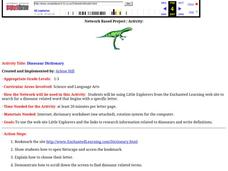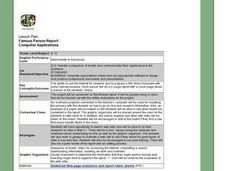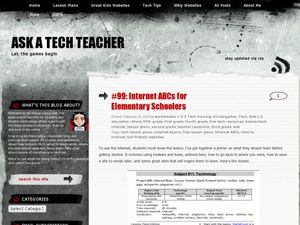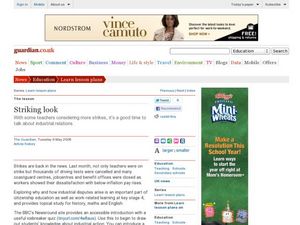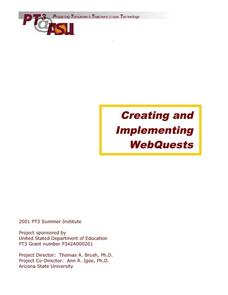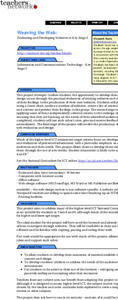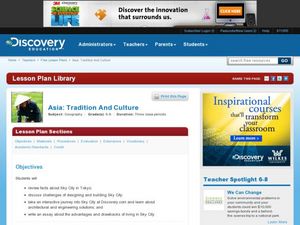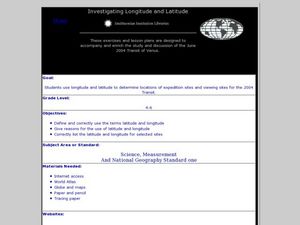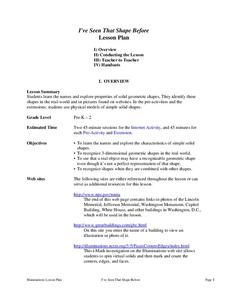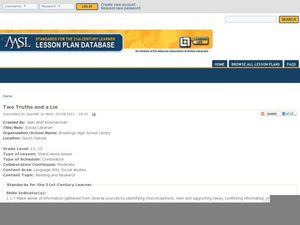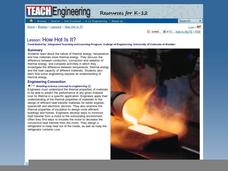Curated OER
Dinosaur Dictionary
Students utilize a web site to search for a dinosaur related word that begins with a specific letter. The words and their definitions are placed into a dictionary page which is then compiled into a class book.
Curated OER
What is Green?
Learners utilize an Internet web site to locate items that are green. A green word bank is created and used to complete sentences. Pictures are drawn to accompany the sentences which are then placed into a book.
Curated OER
Alphabet Sensation
Students research different websites to obtain information about the alphabet. In this Internet lesson plan, students use their knowledge of the alphabet to navigate certain websites.
Curated OER
Famous Person Report - Computer Applications
Learners choose famous person to research online, use at least two different sources to find information, prepare rough drafts and document sources, meet in groups for peer feedback, review with teacher, and turn in final report.
Curated OER
6 C's of Motivation
Young scholars get involved in a Project-Based Learning instructional design model as they enter a problem-solving learning journey. They get to personalize their learning experience from the beginning by making choices. Students set up...
Curated OER
Internet ABC's for Elementary Schoolers
Students develop basic Internet skills. In this lesson introducing the basics of the Internet, students discover how to use toolbars, address bars, how to save a website to revisit later, and how to use the back and forward buttons. This...
Curated OER
Striking Look
Students examine teacher union issues. In this current events lesson, students browse selected websites to explore the work and history of labor unions in Great Britain in order to better understand the teacher strikes of 2008.
Curated OER
Creating And Implementing Web Quests
Students in teacher preparation take a look at using webquests as part of the curriculum. They research what subjects the quests could be used as teaching tools to support. The instructor models a well prepared webquest and then the...
Curated OER
Using Excel to Reference and Graph Live Data from a Web Site
Students collect live buoy data about water temperatures in the Gulf of Mexico from the Internet and work individually to organize their data and create a line graph using Excel Spreadsheet. Students analyze their data and examine any...
Curated OER
Insects
It's a fact: kids love bugs! With this lesson, young learners explore reading informational texts and conducting research while learning about their favorite insects. Spark learners' interest by reading a book about one kind of bug and...
Curated OER
Evaluating and Developing Websites at Key Stage 3
Students develop an awarness of material on the web, critiqueing and creating rather than simply surfing. They create produce their own websites.
Curated OER
EcoKids Web Site: Food Chain Game
Learners use the EcoKids web site to explore food chains and the associated terminology. They answer the questions about food chains and their importance. Students use the Kidspiration program to add information to an Animal Fact Web.
Curated OER
Identify Navigational Instruments Instructions for Teachers
Students, who are teachers, learn about navigational instruments. They complete worksheets by searching for the names of the navigation tools using a websites.
Curated OER
Out of Site
Students determine the benefits of a school Web site for parents, teachers and student. They analyze the role of school Web sites in building community, and outline and design sections for their own school's Web site.
Curated OER
Suspension Bridges: Connecting Lives
Middle schoolers explore bridges. For this bridge lesson, students design and build a suspension bridge after visiting related websites and reviewing famous bridges in non-fiction books. Middle schoolers follow the...
Curated OER
Bill Of Rights
Students examine Supreme Court cases. In this U.S. government lesson, students watch a video about the Bill of Rights and then research 4 Supreme Court cases using the noted web site. Students analyze the presented information and write...
Curated OER
Asia: Tradition And Culture
Students discover Sky City. For this Asian culture and traditions lesson, students watch "Asia: Culture and Tradition," and then discuss the practicality of building Sky City. Students visit a Discovery Education Web site to research Sky...
Curated OER
Investigating Latitude and Longitude
Students examine the lines of latitude and longitude on a map, and explain why these lines might be useful. In this lesson plan students also explore websites that provide information to improve their understanding of how and why...
Curated OER
Flesh Eating Bugs, Moldy Corpses, The Trail of a Killer
Young scholars read about how forensic entomologists use maggots to solve murders. In this forensic science lesson plan, students read an article and answer questions. They go to different websites about evidence and fingerprinting.
Fayetteville Public Schools
I've Seen That Shape Before
The objectives in the resource allow students to explore the characteristics of simple solid shapes. Youngsters learn to recognize the face shapes, corners, and edges that make up 3-D figures by filling in a chart. Lastly,...
Mascil Project
Design and Build Your Own Vacuum Cleaner, Hair Dryer or Toy Car
No vacuum cleaner? No problem, just build your own. Scholars apply knowledge of currents to build a model of either a vacuum clear, a hair dryer, or a toy car. While the class completes the activity, instructors consider gender...
EngageNY
Populations, Samples, and Generalizing from a Sample to a Population
Determine the difference between a sample statistic and a population characteristic. Pupils learn about populations and samples in the 14th portion in a unit of 25. Individuals calculate information directly from populations called...
Curated OER
Two Truths and a Lie: Internet Research Skills
It's tough for high schoolers to assess what is a credible resource and what is not. A helpful resource prompts class members to research a particular topic and record two facts—and create one lie—while documenting the sources. They...
Teach Engineering
How Hot is Hot?
Elementary schoolers identify the three methods of heat transfer: conduction, convection, and radiation. The lesson is mostly lecture-based. When the teacher has finished the presentation, groups of pupils get into teams and they must...
Other popular searches
- Create Teacher Websites
- Spanish Teacher Websites
- Medical Teacher Websites
- Teacher Websites K 2
- Teacher Websites Primary
- Agriculture Teacher Websites
- Teacher Websites Benefits
- Science Teacher Websites
- Health Teacher Websites
- Teacher Websites Critiques
